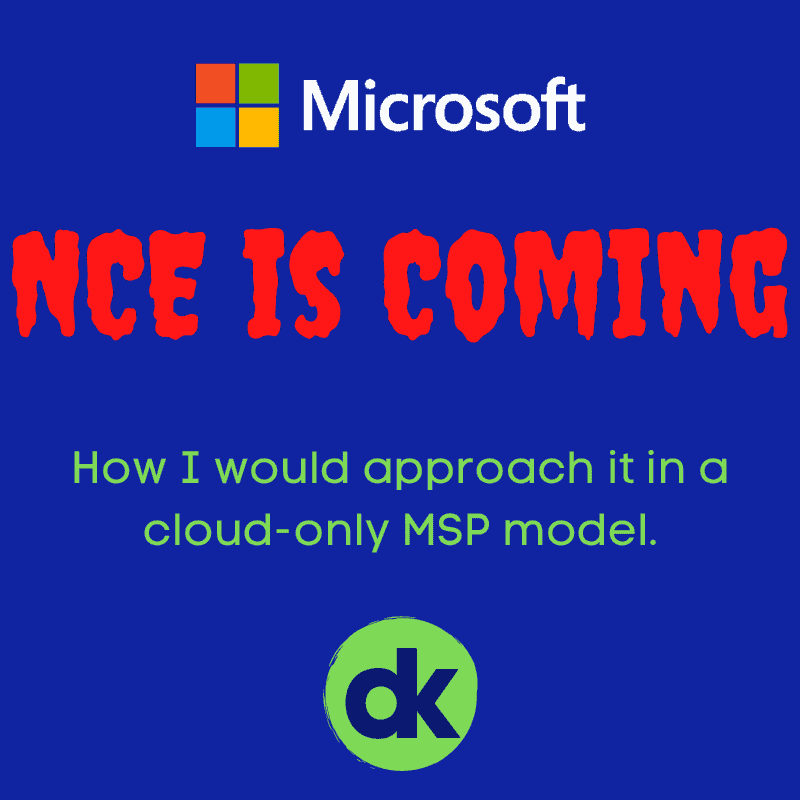Microsoft’s New Commerce Experience (NCE) comes with substantial changes to the way we’re used to doing business with Microsoft. From price increases to extra price increases for monthly terms, it can really complicate your business model as an MSP. In this article, I’ll touch on how I would approach NCE and what changes I would have made to my model. It’s important to note that this won’t work for everyone, and you’ll need to do what works best for your business. Before we dive in, I recommend that you check out Nick Ross’s video on the topic, as he provides really important insight into different ways you can work on your own liability:
Background on my Model
Before we dive into changes I’d make, let me set the scene for how my MSP operated. When I introduce how I operated to folks, I often use a phrase like “modern workplace focused.” I mean that to the core, our entire service wrapped around the concept of Microsoft Modern Workplace. Every one of my customers had moved to full-cloud or they were on the way prior to me selling. It was glorious, low support overhead, standardized security across the board, I miss it sometimes! Most customers were on Microsoft 365 Business Premium (then just “Microsoft 365 Business”) and had AAD for identity, Intune for device management, SharePoint & Teams for collaborating, etcetera. It’s also worthwhile to note that, with few exceptions, our clients were month-to-month. Finally, most clients had one-line invoices. It was “10 users at $x total $y” style billing.
Flexing Around NCE
What I wouldn’t do is modify my service model! Our service model is core to our identity, there’s no reason to scapegoat the business plan. What we should explore are our contract terms, pricing, and potential new sales models.
First agenda item: pricing.
Obviously, our costs are going to adjust here. My step 1 would be to take in all the new costs and analyze them. I would examine different pricing scenarios (with commits, without, etc.). This will create a baseline idea of pricing adjustments I need to make. Personally, I’d simply lay these scenarios out in Excel and tinker with them until I find something acceptable. I’d explore breaking out Microsoft costs, increasing the overall service cost, etc.
Second agenda item: terms.
This is where things can get messy. Looking at what Microsoft is providing, I’d lean towards adding managed complexity to my service offering. Across my customer base, we had a few scenarios.
- Low turnover, high growth: This was the typical customer I had, I love growing companies. In this scenario, I know that they will be adding people over the contract term. If they remove folks, they are going to fill that position.
- Higher turnover, but little change in position count: It’s important to separate “turnover” from “eliminating positions.” Someone leaving the company, but being back filled, is turnover. Their position isn’t going away, just the human. In that scenario, they’ll need the license soon anyways.
- Low turnover, plateaued growth: These businesses have little turnover, and also low growth. These are goldilocks for NCE, stick them on a 12-month and call it a day.
- Seasonal (headcount chaos): This is your tax office and other similar businesses. NCE makes it very hard to service these customers and we end up splitting terms. Fortunately, in my business, our financial firms were mostly full-service and fully-staffed year-round. Nonetheless, I’ll try to explore this scenario with you.
In summary, here’s how I’d approach these customers (or different options thereof):
Option A: Adjust the entire contract term.
One approach I’d consider is committing the customer to the entire contract with me, with a buyout clause that covers my loss to licensing.
| Low turnover, high growth | Higher Turnover, steady position count | Low turnover, low growth | Seasonal | |
| Month-Month | Advise against, turn service contract into commit | Advise against, turn service contract into commit | Advise against | Place seasonal staff on month-month licenses; break out service cost for seasonal vs non-seasonal staff |
| 12-Month | Enter 12-month agreement at current count, add users to agreement with growth | Enter 12-month agreement with either a) license only billing for empty seats OR b) eat cost during hiring process if customer hires quickly or ab) Do both, set a deadline for rehire | This is the best customer scenario, dropping them into a contract is pretty easy as things don’t change often. | Place permanent staff on 12-month contracts |
| Mixed | N/A | N/A | N/A | Mix month-month and commit; split contracts in PSA |
Because my business model was so cloud-centric, dependent on the cloud service, this is likely the approach I’d take. We’d rope our entire IT service into commit-based models. Don’t get me wrong, month to month would be an option. It just becomes a more expensive option. In this approach, I haven’t changed the service model at all. I’m still bringing a complete solution stack. I’m simply modifying the rules of engagement.
Of course, this model works well for the cost per user, cloud-focused, wholistic solution set business model I ran. It won’t work for everyone, so let’s explore the other way.
Option B: Break Microsoft into its own Agreement
As a pretend analyst, I assess that this is likely the way most shops will do it. In this model, we take Microsoft out of our core service agreements. We end up in a model where the customer signs two contracts:
- IT Services. The actual work you do for support, security, management, consulting et al.
- IT Commodities. The customer signs a separate agreement that includes Microsoft licensing, that aligns with the commit term for the licensing.
In this model, you have the ability to separate service from product. This way should a client choose to seek out another IT company, you can terminate the service contract while enforcing the term on the product contract.
Third agenda item: talk to legal!
I’ve started many businesses in my life. Whenever someone comes to me for business advice, I tell them this:
The first three people you’re going to hire are going to be a CPA, an attorney, and a shrink.
Once you’ve assembled your models, work with your counsel to write out contracts for all the scenarios you are going to proceed with. This will help make sure you have your ducks in a row.
And finally, put it into action!
Once you’ve identified the model(s) you’d like to move forward with, it’s time to communicate the changes to customers. Personally, in my business, I’d look at the anniversary dates of my clients and work to lineup my meetings and changes with that. It’s important to be transparent here, explain clearly why things are changing. Market changes are common. For example, our prices changed for inflation annually, it’s just part of business. Be transparent that Microsoft is implementing changes and that you, as their Microsoft Partner, are implementing changes to continue to be the best option for them.
I know that NCE is a massive and frankly scary change. However, I do believe that there are workable solutions so that you can continue to grow in your partner journey.




